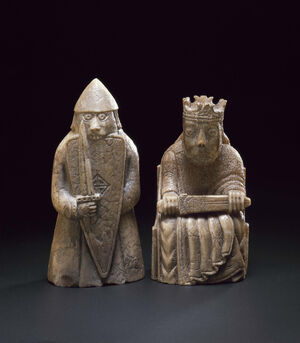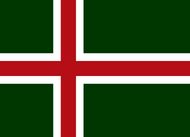| Kazulian | |
|---|---|
| A Kazulian woman in typical Kazulian fashion | |
| Total population | 58 million |
| Regions with significant populations | Kazulia: 55 million
Dranland: 2 million Greater Hulstria: 3 million |
| Language | Kazulianisk |
| Religion | The Pagan Rite 52%
Catholicism 28% Lutheranism 19% |
| Related ethnic groups | Unknown |
Kazulian people or Kazulians (Kazulianisk: Kazuliar) are a Heludic ethno-linguistic in Kazulia. Kazulian people migrated from northern Artania during the first millennium. Kazulians are identified by their speaking of East Dundorfic languages and their location within greater Kazulia, an approximate region in northern Dovani. In general use, the term refers to the Befäskar, Kazul and Skrigere people.
Etymology of Kazulian[]
The English term "Kazulian", as well as the Hulstrian term "Kazulier", comes from the original Kazulian "Kazuliar", which comes itself, like the latin term, from the ancient realm of Kazul. The older Kazulian word for Kazulians, "Kazulianisk Menn" (Men of Kazulia) is hardly used anymore.
History[]
(Main Article: History of Kazulia)
The Origins[]
We don't exactly know when the Kazulian culture started, but it must have been around the year 500. The first evidence of a Kazulian culture, or better, the ancient Kazul culture, a helmet found near the city of Ulfmærr, is dated on 530. The oldes "written" document, which clearly indicates the Kazul culture is an ancient rune stone with the carving in ancient Kazulianisk "Me, Thoarsson Harfax, made this stone for Heiskir Ingrijmsson". However, the time when the Kazul settled on the territory known today as Kazulia, must have been around 600. It is not known whether the Kazul come from another region or originated in Kazulia, but most believe they came from another region, because on some old tombstones carvings are found that tell about the time, when "we came from the land beyond the see". The Kazul could be divided into two subcultures, the coastal Kazul, including those living by the river Krigsvatn, and the landlocked Kazul, living in the plains and the mountaineous regions. While the coastal Kazul lived largely by fishing and even more by plundering others, which gave them a reputation of godless savages in other ethnic groups, and also used a kind of ship-building technique which was one of the best at this time, the landlocked Kazul lived by farming (in the plains), and hunting in the mountains, and to some amount also by plundering each other. Around 800, Kazulia would be completely under Kazul rule, and also in this time, namely 810, a document states that one Harald Leifsson has become king of kings in Kazulia. This leads to the conclusion that there have been different kings in Kazulia at the same time, and most historicians only wish it were so, but in fact the monarchical system in ancient Kazulia is far away from being fully analysed, due to its complexity. We know sure that there were at least 11 different tribes, and it's quite sure that there were another three, each tribe ruled by his own king, but there were not only also "sub-tribes" within the tribes with their own kings, some of them really kings, some of them other aristocrats, but there was also geographical divisions (not only the five herramarkrer of Kazulia, but also some cities, areas, and single mountains) with their own kings, and to make it more confusing, it seems that there were also kings just by title with noone specifically following them. Leader of all those was the mentioned Kungenes Konge, the king of the kings, who was elected by a system even more unclear and confusing than the diversion of the kings.
The Colonisation[]

Stone figures depicting Carl I. (right) and his predecessor Gunnar "Ironteeth" Eigilssonn (left), original size of the figures: 12 cm
However, theses systems become more than overdue when after Dovani was discovered, the Hulstrians came to Kazulia. Shortly after the colonisation of Hulstria begun, the colonisation of Kazulia took place, approximatly about 1500. The Hulstrian came from the South, and soon, due to higher technology, Hulstro-Luthori Lutheranism, and a generally great understanding between both ethnic groups, Hent, Kelvon, and southern Dreton were entirely lutheranian by 1530. Another sign of the good relationship between the groups, and the rise of Hulstrian aristocracy was when Carl I. von Thuen und Tackzis, a Hulstrian aristocrat, became king of kings in 1534. The north of Kazulia remained Kazulian until 1600, when agressive settlers from Egelion started to rush in in a far more oppressive way than the Hulstrians. The northern tribes called the strong Hulstrians for their aid, the strong Hulstrians came, defeated the settlers, and overtook many leading positions in the north, thus bringing the land together under a two-third Hulstrian and one-third Kazulian leadership. Officially, Kazulia was now a part of the Holy Luthori Empire, and was reigned now by a Luthorian gouvernor, but as Luthori never took large interest on what happened in Kazulia, Kazulia remained relatively free, and though the Hulstrians effectively altered the governmental systems in Kazulia, most Kazulians, as they were called after Kazulia became Luthorian, thought of the gouvernor as a direct successor of the king of kings. The Hulstrian colonisation of course was the biggest impact on Kazulian culture ever to happen, and until now, the top layers of society, and generally the aristocracy, consists of only one third of Kazulians, the rest are Hulstrians. Also the pagan rite, Kazulias leading religion, became second after lutheranism and later catholicism. The tribal structure dissolved, and only the dispersion into the five lanner remained. The only impact was the re-Kazulianisation-movement in the period of the Reinessance Enlightened, which lead to the present status, in which Kazulian names, after Latin lost most of its popularity, became fashionable again, the pagan rite got stronger, and a generall reflection on old Kazul virtues and traditions started.
Culture[]
(Main Article: Culture of Kazulia)
Culture in Kazulia can be traced back to 500, but this was the Kazul culture, the Kazulian culture was formed in the Age of Colonisation, when the partly different cultures of the different Kazul tribes merged. However, the only important influence on the Kazulian culture were the Hulstrians, neither the Welsh nor the Gao-Showa had more than a regional influence at the Kazulian borders.
Language[]
Template:Main Article:Kazulianisk
The language of the Kazulians is Kazulianisk, a language of the Dundorfian family, and it's quite unclear how a Dundorfian language could have made it to Dovani. One theory is, that it came with the Kazul when they came over the sea (see here), the other, more appreciated one, is that a great part of the different ethnic groups on Dovani came from the area of Dundorf, which is also supported by the fact, that Welsh is also a Dundorfian language, and one could also see from the great differences between Welsh and Kazulianisk, that Dundorfian must have reached Dovani long ago.
Kazulianisk itself is divided in many dialects, but there is also a standard form, which is the one originally spoken in the area of Kazulia's capital Thorgerd. Also two other languages are spoken by Kazulians today, Latin and Hulstrian, due to the history of Kazulia (see here). The small group of Kazulians living in Greater Hulstria and Dranland of course also speak the official language of their home country.
Relations to other Ethnic Groups[]
- Hulstrian: Mostly, Kazulians and Hulstrians like each other, but from time to time Kazulians remember that there are more powerful Hulstrians in their own country than Kazulians, which can even lead to murder (in one incident so far).
- Welsh: As long time neighbours, the Kazulians don't have as many problem with the Welsh as other groups like the Hulstrians and the Dranian have. When the genocide began, many Welsh fled to Kazulia and were greeted warmly.
- Gao-Showa: There never were many contacts with the Gao-Showa over the ages, and thus, the Kazulians generally don't have a specific opinion on them (the Kazul however had, many plunderings were layed upon the Gao-Showa in their time), and they are normally seen as friendly neighbours.
- Dranian: Also with the Dranian Kazulians have no problem, mostly, when they remember their history, they're just happy that Kazulia wasn't colonised by Egelion, other than Dranland

|
Grand Duchy of Kazulia Skalm (capital city) | |
| Geography • History • Culture • Economy • Government | ||
|---|---|---|
| History | Christopher Dove • Hulstro-Kazulian War • Kazulian Civil War • War for the Emperor's Protection | |
| Geography | Anantonese Ocean • Barrier Range • Great North Dovani Plain Counties: Agatha • Dreton • Flindar • Hent • Kelvon | |
| Politics & government | Council of Ministers • Grand Duke of Kazulia • Political parties in Kazulia • Statsminister of Kazulia • Stortinget | |
| Demographics | Religion: Aurorian Patriarchal Church • Abjurantism • Daenism • Sindo • Vardic Paganism Ethnic groups: Befäskars • Draddwyr • Dranianos • Hulstrian • Kazulian • Kunihito • Kyo • Skjöld • Skrigeres • Sullestian | |

